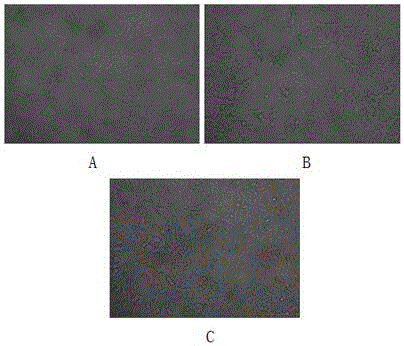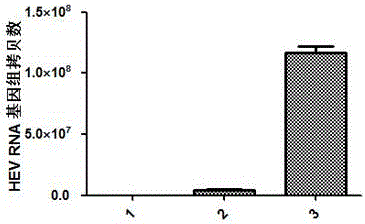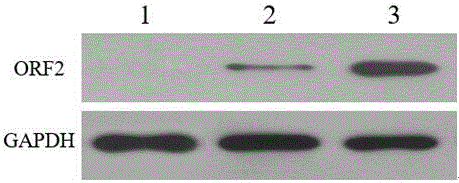Method for cultivating hepatitis E viruses
A technology of hepatitis E virus and virus, which is applied in the field of successfully culturing hepatitis E virus strains in vitro and improving the replication efficiency of progeny viruses, can solve the problems of restricted replication of HEV virus, and achieve the effect of promoting replication
- Summary
- Abstract
- Description
- Claims
- Application Information
AI Technical Summary
Problems solved by technology
Method used
Image
Examples
Embodiment 1
[0019] Embodiment 1: A549 cell culture
[0020] 1. Take out A549 cells (purchased from ATCC in the United States, number CCL-185) from liquid nitrogen and quickly put them into warm water at 37°C to melt the cell suspension quickly; then add DMEM containing 10% newborn bovine serum (purchased from GIBCO Invitrogen Corporation ) culture solution, adjust the pH to 7.2 and incubate at 37°C for about 4 hours, discard all the culture solution, add fresh culture solution to continue the culture, and after growing into a dense monolayer, wash the cells with PBS (purchased from GIBCO Invitrogen Corporation), trypsin – EDTA (purchased from GIBCO Invitrogen Corporation) digested, added to the above culture medium, placed at 37 ° C, 5% CO 2 Continue culturing in the incubator, such as figure 1 A Normal A549 cells are shown.
[0021] 2. Culture HEV with A549 cells transfected with miRNA-A6
[0022] (1) Prepare a 10% weight-volume ratio of PBS (pH7.4) feces suspension from the collected...
Embodiment 2
[0027] (1) After the genotype IV human HEV virus solution was sterilized by filtration through a 0.22 μm filter membrane, a double antibody solution with 1% volume of the virus solution was added, treated at 4°C for 1 hour, and stored at -80°C for later use, and the virus was detected by Real-timeqPCR The copy number is 2×10 6 Copy number / mL, where the double antibody solution is a solution containing 400U / mL penicillin and 1000U / mL streptomycin;
[0028] (2) Divide A549 cells into 2×10 5 Inoculate each well into a 6-well plate with DMEM medium containing 10% fetal bovine serum at 37°C, 5% CO 2 Cells were cultured statically in an incubator until the cell confluence was 75%-80%; cells were washed 3 times with 1×PBS, serum-free DMEM medium was added, and the miRNA-A6 liposome transfection mixture was dropped into the well plate (miRNA -A6 liposome transfection mixture is prepared by mixing conventional lipofectin transfection reagent and miRNA-A6 sequence at a volume-to-mass ...
Embodiment 3
[0034] (1) After filtering the HEV virus solution through a 0.22 μm filter membrane, add a double antibody solution with a volume of 1.5% of the virus solution, treat it at 4°C for 1 hour, and store it at -80°C for later use. The virus copy number was determined to be 2 by Real-timeqPCR ×10 5 Copy number / mL, where the double antibody solution is a solution containing 400U / mL penicillin and 1000U / mL streptomycin;
[0035] (2) Divide A549 cells into 2×10 5 Inoculate each well into a 6-well plate with DMEM medium containing 10% fetal bovine serum at 37°C, 5% CO 2 Cells were cultured statically in an incubator until the cell confluence was 72%-77%; cells were washed 3 times with 1×PBS, serum-free DMEM medium was added, and the miRNA-A6 liposome transfection mixture was dropped into the well plate (miRNA -A6 liposome transfection mixture is prepared by mixing conventional lipofectin transfection reagent and miRNA-A6 sequence at a volume-mass ratio of 1:4, wherein the miRNA-A6 seq...
PUM
| Property | Measurement | Unit |
|---|---|---|
| diameter | aaaaa | aaaaa |
Abstract
Description
Claims
Application Information
 Login to View More
Login to View More - R&D
- Intellectual Property
- Life Sciences
- Materials
- Tech Scout
- Unparalleled Data Quality
- Higher Quality Content
- 60% Fewer Hallucinations
Browse by: Latest US Patents, China's latest patents, Technical Efficacy Thesaurus, Application Domain, Technology Topic, Popular Technical Reports.
© 2025 PatSnap. All rights reserved.Legal|Privacy policy|Modern Slavery Act Transparency Statement|Sitemap|About US| Contact US: help@patsnap.com



